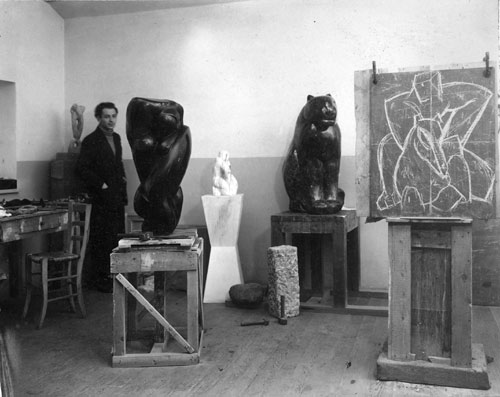|
 | | Heinz Henghes
carved the centaurlike figure that became the book colophon for
New Directions Publishing. A sculptor "wit a vo-ice dot woult
/ meldt dh heart offa schtone" (Canto XXXV, Pound), Henghes
ran away from home to the U.S. while still in his teens and in the
early 1930s walked from Hamburg to Rapallo where he stayed with
Pound. At the bottom of this email is a photograph of Henghes in
his studio at Via Borjonuovo 7, Milano in November 1936. Beside
him is what looks like a chalk drawing on slate of the ND colophon,
which also exists as a marble sculpture in the collection of the
Agnelli family (of Fiat fame). About Henghes, The Times (London)
obit wrote, "In him, European sculpture has lost a versatile
artist and an endearing, eccentric character." |
New Directions
would like to thank Heinz Henghes son, Ian Henghes, for sending
us the photograph. A note he has about the colophon reads something
like: "'Drawing' Colophon of the New Directions Press. Owner
Rene (Renato) Wild Milano & Como. 1935. 60X75cm. Clichee made
of copy." He and friends of Heinz Henghes maintain a beautiful
website where further biographical information and numerous images
of H. Henghes' artwork can be found (http://www.henghes.org). If
anyone has any information or questions on the works of Heinz Henghes,
please write to info@henghes.org. Below are two excerpts that mention
H. Henghes and the ND colophon: one written by James Laughlin, the
other by Ezra Pound in a letter to James Laughlin. JL also published
an "In memoriam" of Heinz Henghes in New Directions Anthology
#33.
from POUND AS WUZ, by James Laughlin (Graywolf Press, 1997):
"One day
when I was in Rapallo, a bedraggled figure with his feet bleeding
turned up on Ezra's doorstep. In Hamburg he had heard that Ezra
had some sculptures by Henri Gaudier-Brzeska, a friend of Pound's
from the London days. Henghes wanted to see them and get advice
from Ezra about his own work. He had no money, so he had walked
most of the way from Germany. In the mountains he had picked up
in a stream bed some small pieces of soft slate and then carved
them with his pocketknife. The minute Ezra saw these pieces he knew
Henghes was good and wanted to help him, as he had helped artists
and writers all his life. There was no extra bed in the apartment,
so he put Henghes up in the large dog kennel on the terrace. He
fed him and, as soon as Henghes was rested up a bit, took him over
to the local stonecutter, the man who carved gravestones. Pound
said, "I will stand good for a piece of stone for this man
and you lend him some tools." Henghes went to work carving
the striking figure of a centaur, which later became the model for
the New Directions book colophon. People do say from time to time
that it is a sitting-down horse, but why shouldn't a centaur rest?
Then Ezra went up to Turin with a photograph of the statue to show
to the wife of the head of the Fiat Company, Signora Agnelli. He
convinced her that Henghes had genius and she bought the statues
for a good price."
Extract from a letter by Ezra Pound to James Laughlin May 17, 1934
(from SELECTED LETTERS of Ezra Pound and James Laughlin, published
by W.W. Norton):
"Heinz
prepared to supply seals, style of that used herewith for 100 lire,
up till Jan. 1st. an. prox. after which the price will rise.
Whether he is
going to prog/into a medalist I dunno. He's working toward a town
pump at the momeng." (sic)

|